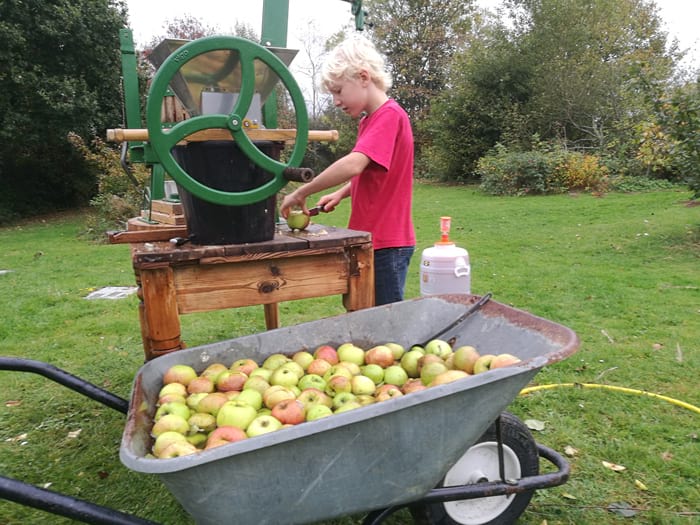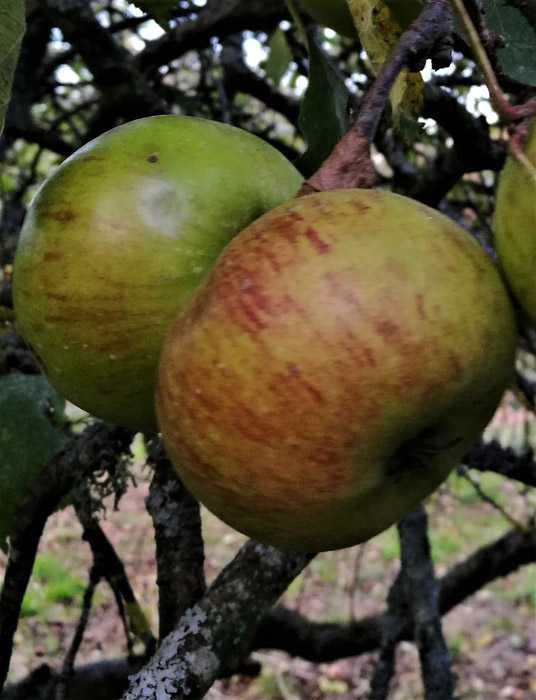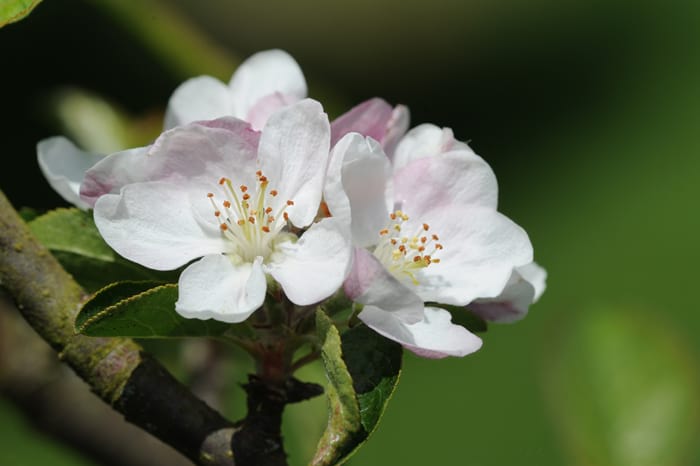Guest post by Dave Goulson
[Adapted from The Garden Jungle, to be published by Jonathan Cape in July 2019]
It was because of my love for cider that I discovered the joy of growing apples, and now apples have become something of an obsession for me. You might wonder what there is to get so excited about. The apple is perhaps the most commonplace and familiar of garden trees; many people have one and don’t even bother to pick the fruit, just allowing them to rot on the lawn (which is not such a bad thing – blackbirds and a host of insects will enjoy munching them right through autumn into early winter). To my eternal mystification, those same people may buy apples in plastic bags from their local supermarket, even while ripe fruit hangs on the tree in their garden.

Apples originated on the flanks of the Tian Shan Mountains on the border between Kazakhstan and China, where wild forests of them still grow to this day, their seeds spread by bears. The familiar fruit of the apple tree is of course a seed dispersal mechanism, intended to tempt a hungry bear or other large mammal to eat it entirely, with the hope that some pips are passed out undamaged and at a distance from the parent tree, along with a healthy dollop of fertiliser to help them grow. Bears are well known to have a sweet tooth (as both Winnie-the-Pooh and Paddington would attest), and so it may well have been selection by bears for the sweetest fruit that resulted in the progenitors of the apples we love today.

So far as we can tell, the Kazakh apples were first domesticated 4,500 years or more ago, back in the mists of prehistory. As trade routes developed through Kazakhstan, apples, seeds or grafts must have been transported both east and west, and there is evidence that apples were being cultivated in the Caucasus and Middle East by 4,000 years ago. Alexander the Great is reported to have found dwarf varieties of apples (popular today for their ease of picking) being grown in Kazakhstan in 328 BC. Apples quickly became a staple food in many of the cooler parts of Asia and Europe, particularly because under cool conditions the fruits can be stored for many months. Some varieties will keep right through to spring, providing an invaluable source of carbohydrates and vitamins at a time of year when, historically, other food supplies were likely to be running low.
Genetic studies suggest that there was some interbreeding between the Kazakh apples and European crab apples during Greek and Roman times, and perhaps this has helped to create the vast array of nearly 7,500 apple varieties that are known today. Yet how many varieties have you ever tasted? Most supermarkets stock perhaps five or six, and these same varieties are found everywhere: Golden Delicious, Granny Smith, Fuji, Gala, Pink Lady and so on. These modern apples tend to be juicy, sweet and crisp, all of which is fine but they are also all rather similar to my mind.
Modern varieties, the ones that dominate the supermarket shelves, were developed during the age of pesticides and typically have little resistance to fungal and insect pests. Varieties such as Pink Lady are hard to grow without a barrage of chemicals, and once a farmer has invested in planting them he is locked in for years, for grubbing up and replacing the trees is expensive and requires several years before the new trees are fully established and producing fruit. In contrast, older varieties tend to be much better at looking after themselves; they had to be, for they were grown without any chemical help. They are also wonderfully variable, each with its own history, distinct flavour, aroma, colour, texture, and keeping and cooking properties. It seems to me rather sad that so few of us have ever had the chance to taste more than a dozen or so of these old heritage varieties, many of which are far tastier than anything the supermarket can provide. Luckily, a great many of these old varieties still exist, and there are specialist nurseries that can supply them, bare-rooted by post in the winter months as maiden or two-year-old trees, or as young potted trees at any time of year though at a higher price. If you have space in your garden you have a choice of many hundreds of apple variety to choose from; the only problem is deciding which ones to grow.
In 2013 I moved to East Sussex with my family, and we were lucky enough to buy an old cottage with a big garden. It had two gnarled old Bramley apple trees, full-sized, maybe five metres tall, crusted in lichens and bending under the weight of fruit in autumn, plus an unhealthy Discovery tree producing red apples pockmarked by scab. The rest of the garden was mostly lawn with a few shrubs. I decided to plant an orchard, using old varieties. I wanted full-sized trees, not dwarf varieties grafted on to slow-growing roots that are now grown commercially (though these are very useful if you only have a small space – the smallest are quite happy in large pots). Traditional orchards used full-sized trees, but their apples have to be harvested by hand and using ladders, which is too labour-intensive for the modern world so instead contemporary commercial orchards usually consist of neat rows of those stumpy dwarf trees that Alexander the Great spotted more than 2,000 years ago.
I figured I had room for about forty different apple trees, each of a different variety, and I spent weeks poring over websites and nursery catalogues to decide which ones to go for. I soon came to the conclusion that my two acres were nowhere near enough, although for the moment it will have to do. I could spend the rest of this book talking about the ones I did buy, and the ones I wish I could have squeezed in, but I guess I should realise that not everybody is quite as interested in apples as I am. However, I cannot resist telling you about a few of my absolute favourites. Let’s start with the oldest. Court Pendu Plat is known to have been grown in France in 1613, but it is widely believed to have been brought to France by the Romans. Apple varieties have to be cultivated by grafting – cutting a twig from a tree and attaching it to a young rootstock – as they do not breed true from pips. Hence the tree in my garden is the exact same individual as the ones grown in France 400 years ago, and perhaps the same as the one which produced apples eaten by Julius Caesar and his legions on his expeditions across Europe. I find that astonishing. Court Pendu Plat apples are flattened, with red-and-orange-striped skin and an intense flavour. The texture is altogether quite odd, with something of the graininess of a mature Cheddar cheese. Some authorities maintain that it tastes better if cut with a knife rather than bitten, but I can’t for the life of me notice any difference.
D’Arcy Spice are crisp and aromatic apples, with a unique, nutmeg flavour claimed by some to be reminiscent of mince pies. The first records of them are from Tolleshunt d’Arcy near Colchester in about 1785. This variety was traditionally picked on Guy Fawkes Day and hung in bags from the trees for eating through the winter. The apples are small and ugly, green and brownish, and heavily russeted (slightly furry to the touch). I can’t imagine a mainstream supermarket ever dreaming of putting them on the shelf, which is a great shame for they are delicious. What’s more, they keep right through to May, so with careful choice of the right trees you can have home-grown apples to eat for all but about ten weeks of the year.
Which brings me neatly to Devonshire Quarrenden, a glorious scarlet apple that is one of the earliest apples to ripen, in late July or August. This is another very old variety, dating back to at least 1690, and enormously popular in Victorian times. They have a distinctly strawberry flavour when eaten straight off the tree, and produce a fantastic red-tinged juice.
And then there is Pitmaston Pineapple, producing small yellow apples that somehow taste nutty, honeyed and of pineapple, all at once. There is Sops of Wine, a tree so abundant in purple pigment that the leaves, petals and even the timber are purple throughout, along with the skin and flesh of the aromatic apples, which when thinly sliced make a very attractive addition to salads.
I could go on, as I am sure you can tell, but I will mention just one more, one that I haven’t yet planted, but which I would love to acquire and squeeze in somewhere among my growing forest of trees (if only I had a bear to live amongst them). Knobby Russet is an old Sussex variety, and is perhaps the least appetising apple I have ever seen. I cannot better a description of the fruit that I chanced upon online: ‘most grotesque … so deformed as to be unrecognisable as part of any living organism’. No doubt the manager of my local supermarket would run screaming at the sight of it, but I’d love to taste one.
It is four years since I planted my trees, and I am quite literally now gathering the fruits of my labours. Not every tree has begun flowering or fruiting, for full-sized trees fruit later than dwarf varieties, but most have, and each year I get to try new ones. Among others, my Ashmead’s Kernel, Crimson King, Beauty of Bath and Cornish Gilliflower have stubbornly refused to flower as yet, but perhaps this spring will be the one. What treats are in store for me.

is also very attractive to red mason bees which time their spring
flight season to match the blooming of fruit trees, and are
amongst the most effective pollinators. (Image by Dave Goulson)
Bizarrely, the UK currently imports about 70% of the apples we consume, many coming from as far afield as New Zealand. Given that we have the perfect climate for growing our own, this seems perverse in the extreme. If we seriously intend to cut down our greenhouse gas emissions (as we must), then importing apples from so far away is a crazy practice that must stop. Instead, why not plant your own apple tree? You’ll soon be harvesting your own, beautiful, tasty, zero-food miles fruit. You’ll also be locking up carbon – your tree will absorb it as it grows. And you’ll be providing food for bees, such as the red mason bee, cute little rust-coloured solitary bees that are fiendishly efficient pollinators of apples (far more so than honey bees). If you’d like to do you bit to save the planet, there are few more positive or rewarding ways to do so than by planting an apple tree today.
Dave Goulson is Professor of Biology at the University of Sussex. He has also written A Sting in the Tale, A Buzz in the Meadow, and Bee Quest, all published by Jonathan Cape.
